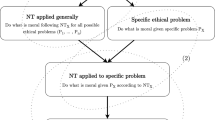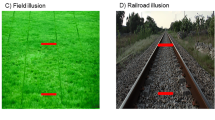Abstract
The ability to reason by exclusion (which is defined as the selection of the correct alternative by logically excluding other potential alternatives; Call in Anim Cogn 9:393–403 2006) is well established in humans. Several studies have found it to be present in some nonhuman species as well, whereas it seems to be somewhat limited or even absent in others. As inconsistent methodology might have contributed to the revealed inter-species differences, we examined reasoning by exclusion in pigeons (n = 6), dogs (n = 6), students (n = 6), and children (n = 8) under almost equal experimental conditions. After being trained in a computer-controlled two-choice procedure to discriminate between four positive (S+) and four negative (S−) photographs, the subjects were tested with displays consisting of one S− and one of four novel stimuli (S′). One pigeon, half of the dogs and almost all humans preferred S′ over S−, thereby choosing either by novelty, or by avoiding S− without acquiring any knowledge about S′, or by inferring positive class membership of S′ by excluding S−. To decide among these strategies the subjects that showed a preference for S′ were then tested with displays consisting of one of the S′ and one of four novel stimuli (S′′). Although the pigeon preferentially chose the S′′ and by novelty, dogs and humans maintained their preference for S′, thereby showing evidence of reasoning by exclusion. Taken together, the results of the present study suggest that none of the pigeons, but half of the dogs and almost all humans inferred positive class membership of S′ by logically excluding S−.




Similar content being viewed by others
Notes
Of course we could have counteracted such effects by rewarding choices of S′. However, what we wanted to investigate were possible preferences for S′ as a result of reasoning by exclusion, not of reinforcement. Also, we suspected that providing partial reinforcement or rewarding the one or the other stimulus type in half of the trials may have led the subjects into searching for some spurious rule according to which reinforcement may be given, and would thus have distracted their focus from more logic-based solutions.
References
Agnetta B, Hare B, Tomasello M (2000) Cues to food locations that domestic dogs (Canis familiaris) of different ages do and do not use. Anim Cogn 3:107–112
Aguirre G (1978) Retinal degeneration in the dog: rod dysplasia. Exp Eye Res 26:233–253
Aust U, Huber L (2006) Does the use of natural stimuli facilitate amodal completion in pigeons? Perception 35:333–349
Aust U, Apfalter W, Huber L (2005) Pigeon categorization: classification strategies in a non-linguistic species. In: Grialou IP, Longo G, Okada M (eds) Images and reasoning. interdisciplinary conference series on reasoning studies. Keio University Press, Tokyo, pp 183–204
Behrend DA, Scofield J, Kleinknecht EE (2001) Beyond fast mapping: young children’s extensions of novel words and novel facts. Dev Psychol 37:698–705
Beran MJ, Washburn DA (2002) Chimpanzee responding during conditional matching-to-sample: control by exclusion. J Exp Anal Behav 78:497–508
Call J (2006) Inferences by exclusion in the great apes: the effect of age and species. Anim Cogn 9:393–403
Cerutti DT, Rumbaugh DM (1993) Stimulus relations in comparative primate perspective. Psychol Rec 43:811–821
Clement TS, Zentall TR (2000) Stimulus relations in comparative primate perspective. Psychol Sci 11:261–264
Clement TS, Zentall TR (2003) Choice based on exclusion in pigeons. Psychon Bull Rev 10:959–964
Coile DC, Pollitz CH, Smith JC (1989) Behavioral determination of critical flicker fusion in dogs. Physiol Behav 45:1087–1092
Cumming WW, Berryman R (1961) Some data on matching behavior in the pigeon. J Exp Anal Behav 4:281–284
D’Amato MR, Colombo M (1989) Serial learning with wild card items by monkeys (Cebus apella): implications for knowledge of ordinal position. J Comp Psychol 103:252–261
Delius JD, Jitsumori M, Siemann M (2000) Stimulus equivalencies through discrimination reversals. In: Heyes C, Huber L (eds) The evolution of cognition. MIT Press, Cambridge, pp 103–122
Dixon LS (1977) The nature of control by spoken words over visual stimulus selection. J Exp Anal Behav 27:433–442
Erdöhegyi A, Topal J, Virányi Z, Miklosi à (2007) Dog-logic: inferential reasoning in a two-way choice task and its restricted use. Anim Behav 74:725–737
Ferrari C, de Rose JC, McIlvane WJ (1993) Exclusion vs. selection training of auditory-visual conditional relations. J Exp Child Psychol 56:49–63
Halberda J (2003) The development of a word-learning strategy. Cognition 87:B23–B34
Hashiya K, Kojima S (2001) Hearing and auditory–visual intermodal recognition in the chimpanzee. In: Matsuzawa T (ed) Primate origins of human cognition and behavior. Springer, Tokyo, pp 155–189
Herman LM, Richards DG, Wolz JP (1984) Comprehension of sentences by bottlenosed dolphins. Cognition 16:129–219
Horne PJ, Lowe CF (1996) On the origins of naming and other symbolic behavior. J Exp Anal Behav 65:185–241
Huber L (2001) Visual categorization in pigeons. In: Cook RG (ed) Avian visual cognition [On-line]
Huber L, Aust U (2006) A modified feature theory as an account to pigeon visual categorization. In: Zentall TR, Wasserman E (eds) Comparative cognition: experimental explorations of animal intelligence. Oxford University Press, New York, pp 325–342
Jaswal VK, Markman EM (2001) Learning proper and common names in inferential versus ostensive contexts. Child Dev 72:768–786
Kaminski J, Call J, Fischer J (2004) Word learning in a domestic dog: evidence for “fast mapping”. Science 304:1682–1683
Kastak CR, Schusterman RJ (2002) Sea lions and equivalence: expanding classes by exclusion. J Exp Anal Behav 78:449–465
Mackintosh NJ (2000) Abstraction and discrimination. In: Heyes C, Huber L (eds) The evolution of cognition. MIT Press, Cambridge, pp 123–141
Macphail EM (1987) The comparative psychology of intelligence. Behav Brain Sci 10:645–695
Markman EM, Wachtel GF (1988) Children’s use of mutual exclusivity to constrain the meanings of words. Cogn Psychol 20:121–157
McIlvane WJ, Kledaras JB, Munson LC, King KAJ, de Rose JC, Stoddard LT (1987) Controlling relations in conditional discrimination and matching by exclusion. J Exp Anal Behav 48:187–208
Meehan EF (1995) Emergence by exclusion. Psychol Rec 45:133–154
Mervis CB, Bertrand J (1994) Acquisition of the novel name—nameless category (n3c) principle. Child Dev 65:1646–1662
Miklosi Ã, Polgardi R, Topal J, Csanyi V (1998) Use of experimenter-given cues in dogs. Anim Cogn 1:113–121
Murphy CJ, Zadnik K, Mannis MJ (1992) Myopia and refractive error in dogs. Invest Ophtmol Vis Sci 33:2459–2463
Neitz J, Geist T, Jacobs G (1989) Color vision in the dog. Visual Neurosci 3:119–125
Odom JV, Bromberg NM, Dawson WW (1983) Canine visual acuity: retinal and cortical field potentials evoked by pattern stimulation. Am J Physiol 245:R637–R641
Peichl L (1991) Catecholaminergic amacrine cells in the dog and wolf retina. Vis Neurosci 7:575–587
Premack D (1995) Cause/induced motion; intention/spontaneous motion. In: Changeux JP, Chavaillon J (eds) Origins of the human brain. Oxford University Press, Oxford, pp 286–308
Premack D, Premack AJ (1994) Levels of causal understanding in chimpanzees and children. Cognition 50:347–362
Range F, Aust U, Steurer M, Huber L (2007) Visual categorization of natural stimuli by domestic dogs (Canis familiaris). Anim Cogn. doi:10.1007/s10071-007-0123-2
Riedel J, Buttelmann D Call J, Tomasello M (2006) Domestic dogs (Canis familiaris) use a physical marker to locate hidden food. Anim Cogn 9:27–35
Savage-Rumbaugh ES (1986) Ape language: from conditioned response to symbol. Columbia University Press, New York
Schusterman RJ, Krieger K (1984) California sea lions are capable of semantic comprehension. Psychol Rec 34:3–23
Stromer R (1989) Symmetry of control by exclusion in humans’ arbitrary matching to sample. Psychol Rep 64:915–922
Szetei V, Miklosi A, Topal J, Csanyi V (2003) When dogs seem to lose their nose: an investigation on the use of visual and olfactory cues in communicative context between dog and owner. Appl Anim Behav Sci 83:141–152
Terrace HS, Chen S, Newman AB (1995) Serial learning with a wild card by pigeons (Columba livia): effect of list length. J Comp Psychol 109:162–172
Tomonaga M (1993) Tests for control by exclusion and negative stimulus relations of arbitrary matching to sample in a “symmetry-emergent” chimpanzee. J Exp Anal Behav 59:215–229
Tomonaga M (1999) Establishing functional equivalence in a chimpanzee (Pan troglodytes) with a two-item sequential-responding procedure. J Exp Anal Behav 72:57–79
Tomonaga M, Matsuzawa T (2000) Sequential responding to arabic numerals with wild cards by the chimpanzee (Pan troglodytes). Anim Cogn 3:1–11
Tomonaga M, Matsuzawa T, Fujita K, Yamamoto J (1991) Emergence of symmetry in a visual conditional discrimination by chimpanzees (Pan troglodytes). Psychol Rep 68:51–60
Vincent-Smith L, Bricker DD, Bricker W (1974) Acquisition of receptive vocabulary in the toddlerage child. Child Dev 45:189–193
Wilkinson KM, Dube WV, McIlvane WJ (1998) Fast mapping and exclusion (emergent matching) in developmental language behavior analysis and animal cognition research. Psychol Rec 48:407–422
Zentall TR, Edwards CA, Moore BS, Hogan DE (1981) Identity: the basis for both matching and oddity learning. J Exp Psychol: Anim Behav Process 7:70–86
Acknowledgments
The research was supported by the Austrian Science Foundation through Grant V3-B03 to Ulrike Aust and by the European Community’s Sixth Framework Programme under contract number: NEST 012929. Thanks are due to Wilfried Apfalter, Johanna Kramer, Katharina Kramer, and Michael Pollirer for their assistance in the pigeon laboratory, and to Karin Bayer and Stefanie Riemer for their help in carrying out the experiments with the dogs. We would also like to thank Christian Palmers for providing the facility for the dog experiments. Also, we wish to thank Julia Fischer for valuable comments and discussion. We declare that the experiments comply with the current Austrian laws.
Author information
Authors and Affiliations
Corresponding author
Electronic supplementary material
Below is the link to the electronic supplementary material.
S2 (MOV 3598 kb)
S3 (MOV 3743 kb)
S4 (MOV 3969 kb)
Rights and permissions
About this article
Cite this article
Aust, U., Range, F., Steurer, M. et al. Inferential reasoning by exclusion in pigeons, dogs, and humans. Anim Cogn 11, 587–597 (2008). https://doi.org/10.1007/s10071-008-0149-0
Received:
Revised:
Accepted:
Published:
Issue Date:
DOI: https://doi.org/10.1007/s10071-008-0149-0




